
Are you sabotaging your own business with terrible marketing? If you haven’t updated your website in the last decade or posted to LinkedIn in recent memory – you may be! Too many geospatial businesses undervalue marketing, dismissing it as “fluff” or worse, “a waste.” But guess what? By not investing in quality marketing, you’re actually harming your business.
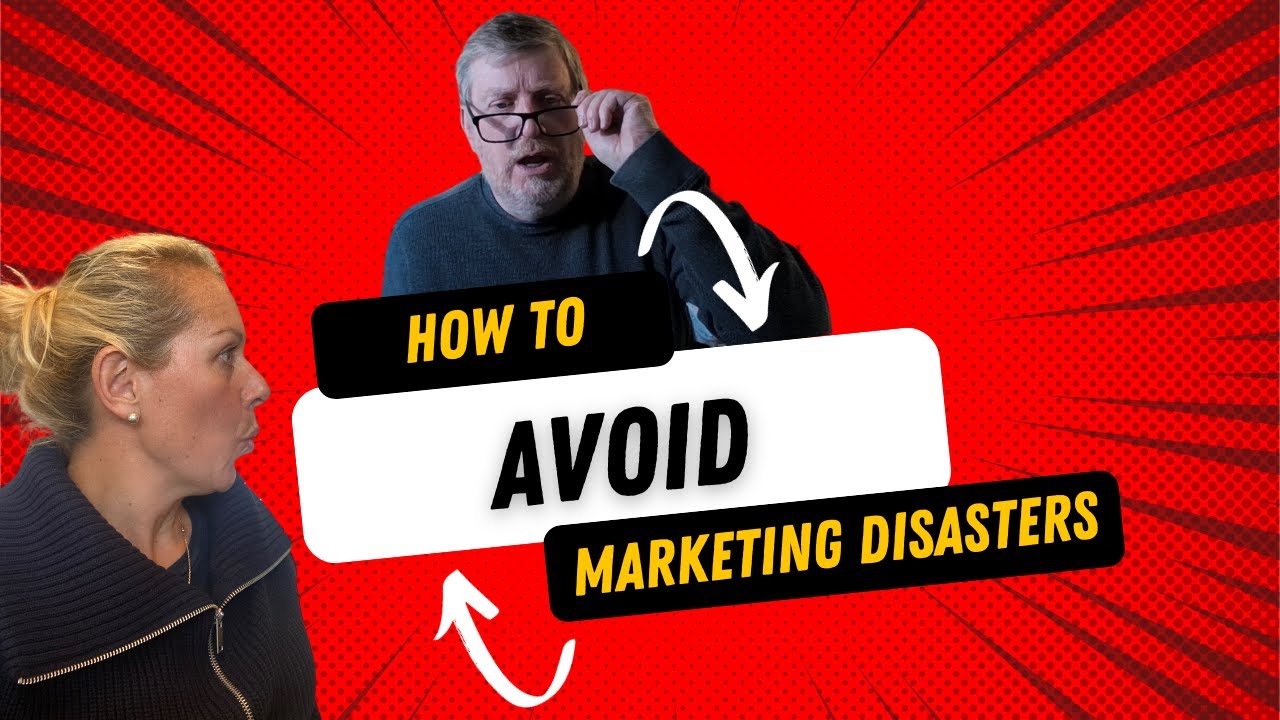
In this on-demand webinar, Elaine Ball and Kevin Corbley explain HOW TO AVOID MARKETING DISASTERS. Learn the pitfalls you need to avoid, exactly how harmful they can be – and how easy they are to dodge.
To view this video, simply fill out the quick easy form below. By filling in your details, you opt in to Elaine Ball’s marketing bumf – read our Privacy Policy to see what that means.
ChatGPT and AI checklist:
✅ Don’t get left behind – it’s going to become your new best friend and will be a huge boost to your marketing, embrace it now
✅ Be specific with your query – asking it to write about surveying is too vague, asking it to write about surveying a rocky terrain will yield better results, the more specific the better
✅ Remember to review – it’s still very new so make sure you still check it’s accurate and right for your audience
Ball’s Golden Nugget; Time to test and learn!
Want to get your social media content the best it can be but don’t know how? Talk to me…
I get it, social media can seem pretty overwhelming if you’re just getting started. You might see other companies and even competitors doing it, and wonder how you can get your marketing looking and sounding how you want it to? Or wonder how you can use it to get the PERFECT clients and ATTRACT the right leads that will make a difference to your business?
This is where I can help.
My Geospatial Marketing Academy will help you to understand what content you need, where you need it and how to make it all work seamlessly together to make your social media channels work perfectly for you.
I’ll teach you the basics, help you understand each of the platforms and what they can do. The GMA is a foolproof way to get confident at marketing, content and levelling up your content on social media so you can make more sales and create bigger, better success.
LinkedIn – You NEED to use Creator mode
I mean, you’ll already know that I LOVE LinkedIn, it’s by far one of my favourite platforms! It’s a brilliant way to network, grow your audience and speak to those in your industry and sector. Yet getting the most engagement isn’t just down to content, if you activate Creator mode you’ll find a whole new way to engage your people.
Using Creator mode will make your profile optimised for discovery, which means your posts will be more visible to your target audience. You’ll also get additional insights and analytics that can tell you what’s working – and what isn’t, which are invaluable!
Creator mode also unlocks new features you simply don’t get with a basic profile. From a badge for your profile to changing your profile image into a mini video; it’s time to think about how your profile sells you the first time a potential lead sees it.
LinkedIn checklist:
✅Add CTAs (call to actions) to your LinkedIn profile and tell your target audience exactly what you want them to do – from downloading rate cards, visiting your website or sending you a message
✅Hashtags, hashtags, hashtags – the more unique the better and you’ll get the chance to actually OWN a hashtag with your content if it’s something that people wouldn’t typically use so choose something unique for your brand. LinkedIn recommends 2-5 targeted hashtags per post.
✅Commenting is your currency – LinkedIn expert Judi Fox explained that to build awareness you should be using comments but not just saying something for the sake of it. Your comments need to add value and insight to spark conversation.
Ball’s Golden Nugget; Use the star feature to bookmark who you want to talk to and work with
If you are in Creator Mode on LinkedIn, the Star feature will become your new favourite tool.
You can ‘star’ potential people you want to work with, do business with or engage with so their content comes up in your feed first – it’s perfect for sales and business development!
Instagram – engagement is the key
Instagram is sometimes a tricky channel for us geospatialers!
Why?
I hear you Geospatialer!
Difficult, but not impossible as Slugsy100 demonstrates
Two examples highlighted at Social Media Marketing World in March 2023; were language app Duolingo and influencer Miss Excel. Both have ZERO to do with the world of geospatial but there’s HUGE lessons to be learnt here!
Instagram checklist:
✅ Creativity – this is the perfect platform to get weird, different and just be creative with your content. On Instagram, weird works!
✅ Tips and hacks work well – imagine how well surveying tips could work!!
Ball’s Golden Nugget; Think about what you want to say and cut it in half
The key with Instagram is short, snappy videos, in fact the prime length for a video reel is between seven and 15 seconds but experts think ten seconds is the ideal
For stories, you get up to 60 seconds of video but data shows many users flick past after just ten seconds so keep it short, to the point and your audience will engage.
YouTube – How to create content that keeps people hooked!
YouTube checklist:
✅ Content, content, content – create what your audience wants to watch and they will watch it to the very end
✅ Have a scroll stopping thumbnail – it’s the first thing your audience sees so it needs to be bright and bold enough to make someone stop the scroll
✅ Have an eye catching title (see Rami’s below) – make your audience want to click the title and view your content to find out more from you

Ball’s Golden Nugget; Your video attracts your people
I say this all the time in the Geospatial Marketing Academy, to get attention from the right people (those important leads and potential clients) you need to be speaking to the right audience. Learn more by watching this
Welcome to my GOT BALLs, a monthly blurb by me, Elaine Ball – your Geospatial Marketer. Giving you the best Geospatial Marketing Resources possible. If this news-letter was forwarded to you, you can subscribe here.
Happy 2023 – I bet it already feels like the Christmas holidays are a distant memory as the new year gets underway!
But it’s time to get back to work and make this year your best one yet 💫
This year is all about getting the most from your MARKETING Geospatialer!
Using the channels and content that work the best for YOU.
If something isn’t working, it’s money wasted and who wants to be pouring moola £££ down the LOO 🚽?!
First up, let’s look at debunking the mystery around influencer marketing
What it is
How it works
Why it NEEDS to be used more in the geospatial industry…
Influencer marketing has really kicked off in recent years, yes its a bit of a buzzword but actually the term ‘influencer’ became popular in the 2010s and was officially added to the English dictionary in 2019.
An influencer is ‘one who exerts influence : a person who inspires or guides the actions of others’.
Often, specifically ‘a person who is able to generate interest in something (such as a consumer product) by posting about it on social media’.
It has quickly become the backbone for a lot of businesses and is a seriously powerful way to
build brand awareness 💙
reach a target audience 💙
build trust and authority with people 💙
All things you want, if you didn’t know that already!
In the early days influencer marketing was just used for fashion, beauty and ecommerce brands sending products to celebrities and famous faces in return for advertising.
But it’s evolved so much since then! And its encroaching into Geospatial😱
Now it’s about finding those people with influence and followers, who are listened to and who can offer guidance and expertise to their audience.
Choosing your influencers isn’t just a snap decision.
Like any part of your marketing, it needs strategy and research. Next month, I’ll reveal exactly HOW to choose the right influencers for your business, as well as how to know if and when they’re working for you.
For now, let’s keep it simple.
At a basic level, influencer marketing means using people with a similar social media following/ audience to help spread the word or showcase your product or service.
This could be through social media channels such as LinkedIn, Instagram, YouTube, or through in-person events. Not only does this build brand awareness, but it gives a view from an ‘impartial’ third party which can lead others to want to engage, connect or buy from you too.
Influencer marketing can open you up to new audiences and help you to find those ideal customers
It’s important to align influencers with your business.
It’s no secret that the geospatial industry isn’t always the most up to date with marketing trends, in fact, most businesses in our sector are waaaayyyy behind the times.
But influencer marketing is one area we really shouldn’t be dragging our feet about.
I see you geospatialer, sceptical and wondering if I’m going to shove a Kardashian in your face.
Panic not, that won’t be happening!
Influencer marketing makes so many people think about celebrities selling teeth whitening or protein shakes but it is so much more than that. In every industry, no matter how niche, influencers are
have authority and
are making people sit up and listen
Now more than ever, the geospatial industry should be using this underused marketing tool and harnessing the power of influencer marketing
It’s only going to get stronger and better!
Be one of the newbies on this bandwagon
Don’t let your competitor beat you to it
Harness the power of the right influencers and their audience to expand your reach and see your business build strong relationships with new and existing customers.
If you’re wondering where you find these amazing geospatial influencers, then you’re in luck – I’ve done the hard work for you and found those that are making some serious moves in our industry…
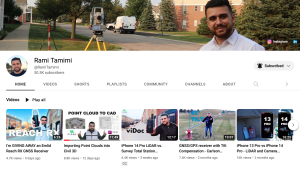 See him here
See him here
Rami with an impressive 50,000 followers on Youtube and growing is a young graduate and one to watch who I predict will go on to do BIG things!
For those keen to learn more about the geospatial world, Rami’s educational content explains different aspects of surveying and he has a young and engaged audience who will be the surveyors of tomorrow as well as surveyors of today.
Any company keen to target young people and showcase the range of careers in geospatial or even in their own business should consider working with Rami as he’s tapped into the younger market in a fun and informative way.
I love to see Farrah’s content as a fellow woman in the geospatial and surveying industries – she is a hardworking female and ‘Surveying Adventurer’ who is doing it all!
She helps run her family surveying business alongside studying and family life with her children, and her content shows surveying and mapping as the fun profession it is.
From full high-vis to getting down and dirty with drones, her day in the life content shows just how different everyday in survey can be. She’s a shining star for the future of the industry and if you have followed her over the years you will have seen how much she has developed and grown in her own confidence as a female surveyor in a male dominated profession. GO FARRAH!
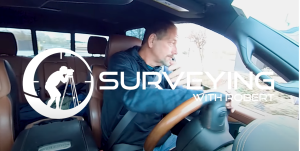 See him here
See him here
Robert is a trusted voice within the surveying world and his honest and trustworthy reviews don’t pull any punches. He says what he thinks, and his audience love him for it.
With over 8,000 followers, his audience might not seem huge but it’s highly engaged and they follow him for his content that ranges from all things Trimble to surveying tips and tricks for being out in the field.
He’s an authoritative voice that shows the range of technology, innovation and the depth of surveying from someone who works in it everyday.
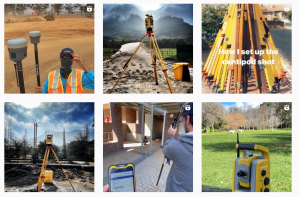 See him here
See him here
Landman (what a cool name for a surveyor or what!) is a working surveyor in South Africa that showcases the surveying profession in a cool way via his Instagram account.
Using reels, stories and grid content, he shows how his Trimble equipment works in the surveying industry and let’s face it – he’s in one of the coolest locations direct from Cape Town!
He attracts over 11,000 followers from around the globe who are fascinated with is eye catching content
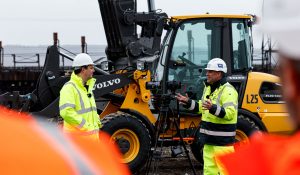
Taken: 8th May 2021 Tees Valley newly elected Mayor (2nd term) Ben Houchen with the new Volvo Plant excuvator. Image Byline: Dave Charnley Photography.
See him here
Peter Haddock is a journalist, vlogger, podcaster and a voice for the construction industry with a lot of experience from geospatial and surveying.
Peter knows how to ask questions and naturally deep dives into how stuff works! You will have an instant liking to his catchy personality which shines through on every video.
Get linked up with these amazing-balls people – they will not only boost your creative juices but are they an ideal influencer for your business?
Yours Elaine
PS: Would you like access to more content like this? Something that will get your marketing boosted throughs the roof.. first watch this.
Connect with me on LinkedIn here!
Show advertisements vs own marketing?
Nearly all trade shows offer their own marketing (and therefore advertising) services as it is a great way to automatically gain the eyes of the attendees! However, this comes at quite a hefty cost.
We at Elaine Ball Ltd are here to discuss other methods which might involve a bit more time and effort, but could save you £££!
Let’s look at our top 5 marketing tips to look into as well as considering the shows marketing packages:
Have you thought about joining a panel discussion with industry colleagues to discuss a topic that is important to you/your company, or even relevant to the industry as a whole?
Have you previously hosted webinars to teach potential clients about your companies latest venture? Why not put that forward to present on one of the stages at the trade show? Attracting those who are intrigued by your
Although this one is a bit of a slow manual process it is definitely one of the most rewarding… starting conversations on LinkedIn with industry friends you are already connected to. Of course these people need to be carefully selected to ensure they may actually be eligible to be approached by your company. Then you can do one of the following:
-A hot lead ‘Hello…, thought I’d mention that I’m heading to… next month. Will you be there? It would be great to link up for a coffee to discuss…?’
-A warm lead ‘Hello, are you attending … this year? I’ll be there at … stand and it would be great to chat to you, we have … (something interesting on your stand to hook them in)’
-A cold lead/ brand new connection who you’ve seen is attending the show ‘Hello, great to connect. I see that your company is attending … will you be there? It would be great to see you at … (more details about the hook from your stand)’
Always add a note when inviting a new connection. Its friendly and warm! Who wants a cold caller!
It’s no lie that conferences are packed full of different companies all trying to attract similar attendees and potential clients. This is where you have to THINK about what your company really wants to get out of the show. Can you make your call to action FUN? Or could you even make it interactive?
Your stand needs to aim to INTRIGUE attendees who pass by. Build curiosity!
They should look at your display boards and want to know more.
Your display hooks them into starting a conversation. You want to get this person into your network.
(note how I say network and not sale… the key here is to not force your product/service as they are still a relatively cold lead having just discovered your company).
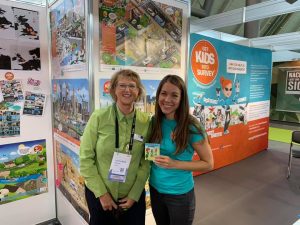
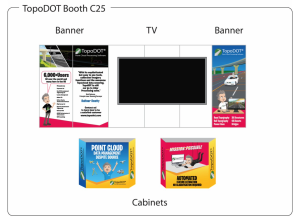
Don’t just wait until you are at the event to begin posting about it. You should be prepping a couple of months in advance to try to target as many possible attendees as possible. Find the best #’s that reach the correct people who are going to the event. Usually the organisers will signal these in the ‘media pack’ that you get beforehand. This pack should include some graphics which you can use on socials and tailor to fit your logo/branding too!
There are usually allocated slots to write about your company or submit PR style articles to. This gives the organisers content to post and also helps to boost your company’s name. Often these emails requesting content like this gets pushed to the back of your to-do list (yes- I see you!!) but try to shift your mindset… it could be really beneficial.
If your company is associated with certain industry associations try to target them too. They could pop a little snippet in their newsletter, or post a little blog about your attendance. All good to boost the visibility of your company, with clear branding this can be even more obvious to repeat viewers.
Are you exhibiting for the first time or need a refresher of the go-to preparation checks? Well you’ve come to the right place! Our team have been to plenty of shows over the past year so have compiled a list of the most important actions that you and your team should be following before the big day:
Where is your hotel in comparison to the show? Check in and establish your base for the event. Booking of hotels usually happens the night before and after the show to give the team a chance to set up and dismantle the stand (and for social activities if networking).
The exhibition organiser should have a list of recommended hotels to choose from but don’t be fooled if they offer a discount, we usually find our own as its much cheaper however if you are a small team then i’d recommend using Airbnb
This could be flights, trains once you arrive there, parking at the airport, whatever method you decide make sure you book! If it’s a busy event then it’s likely many other people attending will be trying to make arrangements for the same time! For busy shows like Intergeo for example, try and get flights booked 6-months in advance to keep the costs as low as possible
Do you have the correct cards ready for purchasing expenses (in another currency)? Is there a spending cap for staff members? How are they invoicing? Make the arrangements beforehand to save hassle on the way back. Golden nugget; use an app like NerdWallet or Evernote as you can tag the shows you are going to within it and share with colleagues i.e. your accountant.
You’ll likely have access to an online portal for the event, here there are tickets not only for the event, but for set up and dismantle too. Make sure you are prepared so there are no hold ups once you arrive, you’ll want to head straight in and start setting up, not faffing around checking identities!
Hopefully you’ll have long sent off your equipment if going by courier, however, double check you have confirmation emails and sign offs for all of your bits and bobs. If they are being held in a certain area, ensure you have the details written down so you can go and collect the items (lucky you if you’ve paid for the trade stand delivery option!).
Does your team know the verses like the back of their hand? If the answer is no then try harder! You should be able to get to your call to actions clearly and quickly. You should all be on the same page, wanting the same actions to come from your company’s visit to the trade show.
If you get flooded with a hive of activity when at the event, you need to be able to collect their information. Gather it on a pre set up device so that you can contact them as soon as the event has ended… jump on your hot leads and DO NOT let them get away.
Who else is attending the event? Have your company reached out to potential clients/customers to let them know that you’ll be there? The pre-show campaigns are some of the most important so don’t skip it… they are already warm (link to customer journey blog) in your customer journey as they know you/your rep, so speaking to them in person is more likely to seal the deal than someone who has only just discovered who you are!
There are often helpful panel discussions and industry leaders hosting various sessions throughout a trade show. Make sure you look at the programme before the event and allocate time to support and listen to your industry mentors. Remember that the show is a place for you to learn as well as making gains for your company. Learning some new information might help you more in the long term…
People will browse between many different stands in a day (or multiple days) so you want them to remember your company. Lots of companies go for the freebie approach; this could be a good way to draw people in, however, if people are genuinely interested they will take a business card or show handout. So make sure you have plenty of branded business cards or freebies to give out to potential clients.
Join GOT BALLs News-letter and keep up to date with the latest news, tips and tricks! Click here to subscribe!
For Geospatial Sales folks! Pssst and Geospatial Marketers
Exhibition booked, now you are excited to get stuck in, catch up with long lost acquaintances, meet new folks and attract potential NEW clients! Woohoo
What are some of the things you should do before, during and AFTER the exhibition to boost your ROI (return on investment)? In other words, get back that investment you have handed-over to the show organizations! At least twice if not many times over!
Here are my top 10 tips for better more successful ROI on your Geospatial Exhibition:
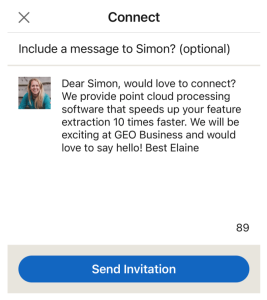 Before you even set foot at the Exhibition – construct a list of potential buyers who might be attending or you can invite to your stand at the show. Use LinkedIn to canvas the market, choose your ideal candidate and invite them as a connection?
Before you even set foot at the Exhibition – construct a list of potential buyers who might be attending or you can invite to your stand at the show. Use LinkedIn to canvas the market, choose your ideal candidate and invite them as a connection?
👈 REMEMBER to Personalise your invite!
Build that list and AWARENESS. You wouldn’t open a shop and not tell anyone you were there would you? So don’t do it with an exhibition.
A campaign is an organised course of action 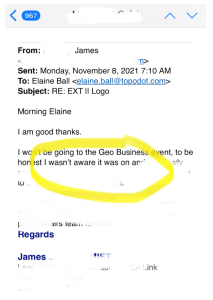 to promote or sell something. It’s used in conjunction with your current marketing efforts. Use some of your marketing on the exhibition itself to build awareness. For example; the goal is to invite 100 people to the exhibition. Using LinkedIn, roll out a 10 tips for 10 days leading up to the show – build your LI followers and build your awareness you are attending!
to promote or sell something. It’s used in conjunction with your current marketing efforts. Use some of your marketing on the exhibition itself to build awareness. For example; the goal is to invite 100 people to the exhibition. Using LinkedIn, roll out a 10 tips for 10 days leading up to the show – build your LI followers and build your awareness you are attending!
Recommendation: Start 3 months before BUT realistically it’s more like 4 weeks
Have a landing page folks can visit to see what you will be showcasing or use LinkedIn’s latest feature ‘Newsletter’ and showcase what you’ll be showing. Direct message your prospects, build social media presence and contact directly.
Send out a message or two to your database via email or LinkedIn inviting them. Making them aware that you are attending! It not only sparks conversation but it boosts your chances they will visit.
Especially if you are a larger organisation! I’ve spoken to many Geospatial Marketers and they can’t track leads from shows because ‘the sales people don’t put them into the database”
TopoDOT use an iPads with forms on that are linked direct to salesforce. No more messing about with cards.
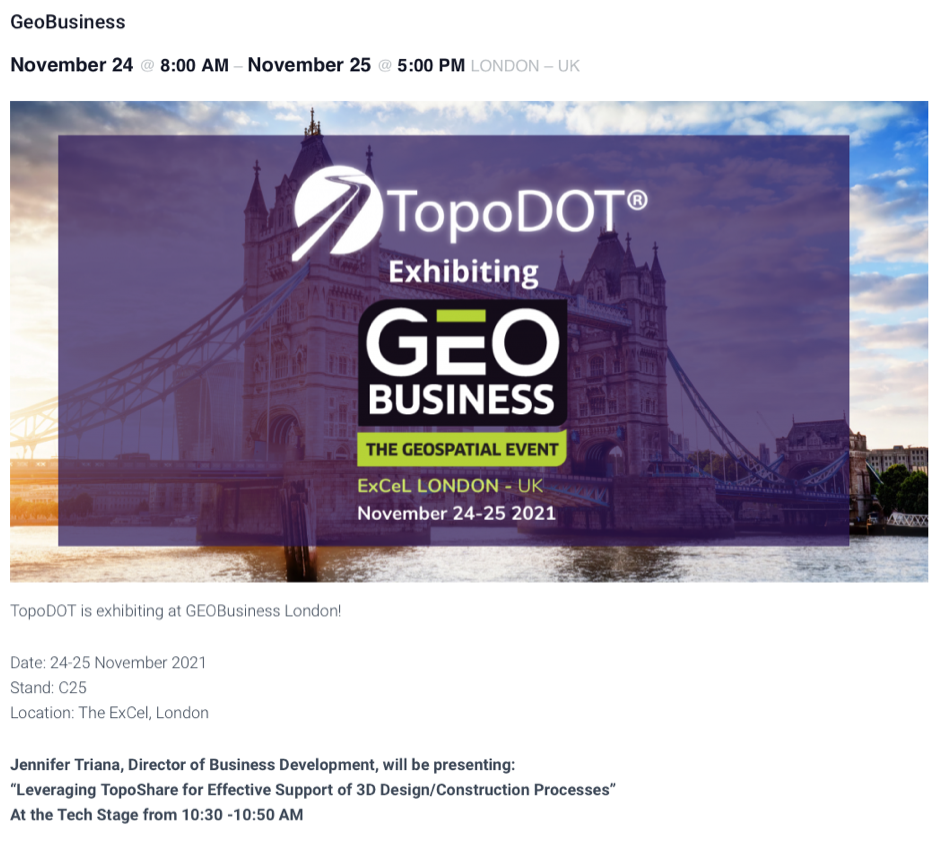 Simple things to fill in like name, company, time frame to purchase, would like a demo? Met at [tick] exhibition, linkedin [tick] and email address.
Simple things to fill in like name, company, time frame to purchase, would like a demo? Met at [tick] exhibition, linkedin [tick] and email address.
If you don’t have a database; have a form that is simple to fill in and staple their card to the form. This however is SLOW and will cost you time! Plus you may miss things out! So be warned!
Go on the prowl, say hello to people, get chatting – don’t stand like a lemon on your stand – talk to those opposite you! There is nothing worse than seeing someone sat on their ass tapping away at their computer. You would find it rude if you walked into a shop! So don’t do it at a show!
Sounds basic right? But have a commonly known call to action whilst you are there to gain leads. What is that criteria? Be specific and get the correct people who want to buy your product.
It works like a treat! I work for Point Cloud Processing Company TopoDOT. Now point clouds are …. Lets face it B O R I N G? (well to the majority anyways) so inject some craziness into your exhibition stand itself! For TopoDOT apart from wild graphics that showcase a pretty boring mundane subject, we also have a live show of the software – showcasing point cloud processing and how to feature extract. This not only attracts visitors, it builds an audience.
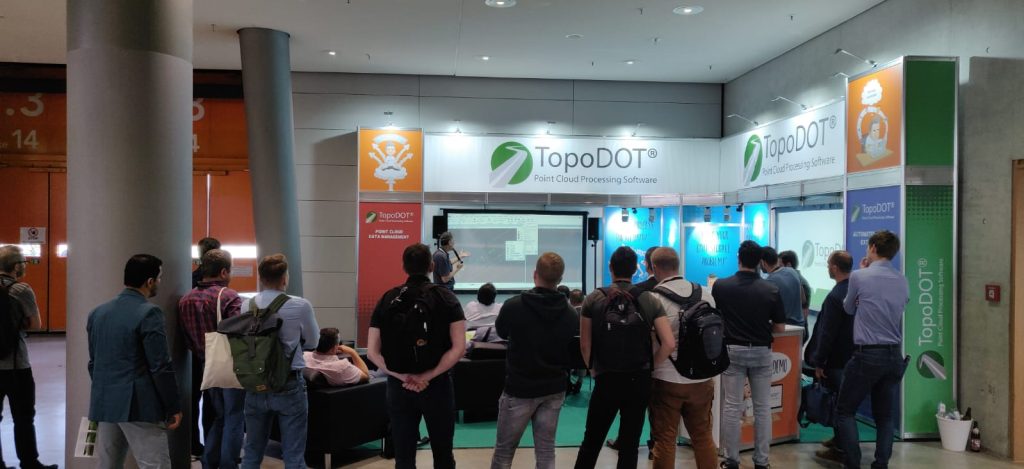
This is pre-show and during… WHY should people take the time out to come to your stand? In fact tell them why they should PRIORITISE visiting you. This could be the launch of a new product, the chance to speak about special time restricted offers, etc
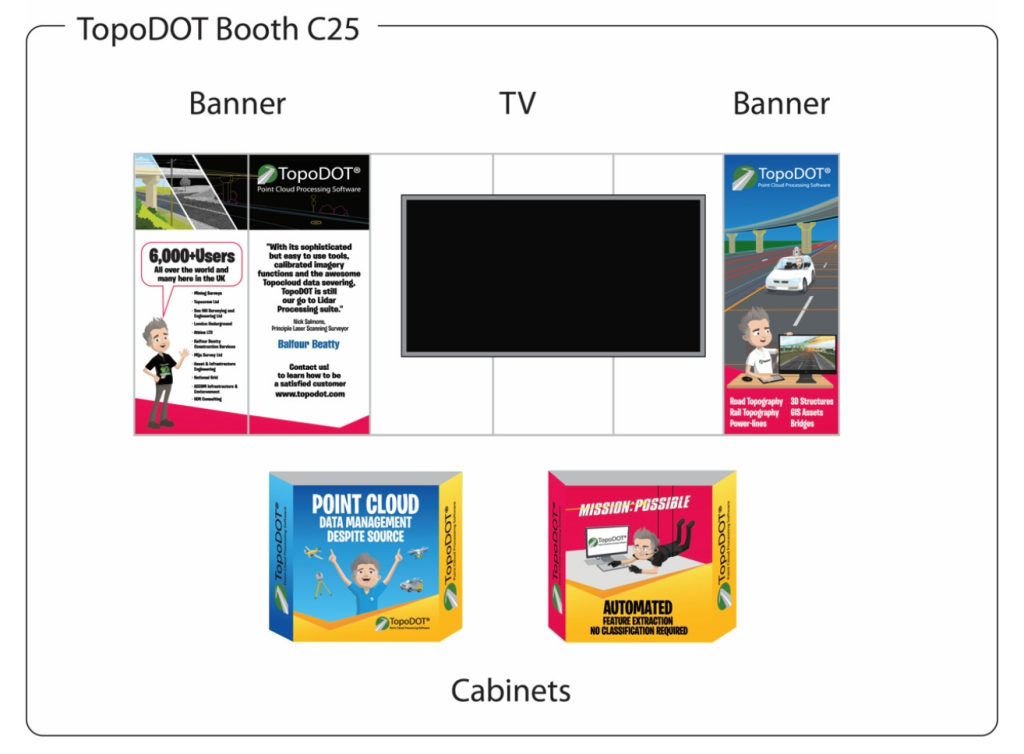
Make it clear who you are. Wear your badge and colours with pride, wonder around and intrigue the other conference goers. The more exposure you give yourself the more people will start to identify you in a crowded room!
That’s right, get out there, stand up on some of the stages to join panel discussions etc. The more your voice is heard the more your name is heard, which has major repercussions for your brand (positively)!
Discussions are great and often not too formalised, which is an easier way to get used to public speaking. If you are confident then by all means go and present that super presentation of yours…
Join GOT BALLs News-letter and keep up to date with the latest news, tips and tricks! Click here to subscribe!
Audience: Owners of Survey Firms / Sales and Markeitng Managers of equipment sellers
Marketing and sales play a very important role within ANY business. In a nutshell, they should attract more of your best type of customer, ya know the ones who pay well, don’t fuss and let you get on with the job! The ultimate goal of both is to bring in more revenue at a profit.
Firstly we need to understand the full customer journey, the whole parts of the journey. From the pre-buying journey where the prospect doesn’t even know they have an issue, let alone know who you are – to the buying journey when they know they have an issue and are searching for a solution.
Hear me out…
Understanding the full customer journey is key to understanding the sales and marketing roles. How they work together to close the gap and win business.
The Geospatial Sector is what I call a “heavy sales-led industry”.
Sales-led is the growth strategy where your sales processes and team take the driver’s seat to grow your revenue, according to YAAGNESHWARAN GANESH.
Meaning the company’s success depends on how well the sales team performs.
Our Industry and the Survey Profession are very similar. It doesn’t matter if you are selling a tool or a service; the sale is complex involving multiple buyers.
Sales folks use tactics like cold calling to fill the sales pipeline. It is heavily person to person interaction. When said prospect is hooked, it’s up to the seller to convince the buyer to purchase.
Sound familiar? (especially for those product sellers out there)
This is very traditional and the way we have always done things within the Survey Profession and overall Geospatial Industry.
It’s ingrained
It is in our blood
So why am I harping on about Marketing if the Industry is sales-led and it works? Or does it? BIG FAT QUESTION MARK???
Sales refers to all activities that lead to the SELLING of your stuff! Like picking up that phone, answering an email request or meeting someone at a show. It’s the after part of the customer journey. The prospect knows what they want to buy.
The Marketing element is the PROCESS of getting people EDUCATED and INTERESTED in your stuff before they know they have an issue. Educating them on the problem and how to solve that said problem.
Marketing warms up the market you are targeting.
It is not advertising alone
It is not designing a brochure alone
It is the things you do to close the gap between the problem the audience has and the thing you are selling to solve it.
By visualizing the full customer journey first it is much easier to understand where both subject matters fit within the journey. How they intertwine and how they work TOGETHER on the leads.
When this is understood, sales-led organizations will improve their overall sales revenue and profit.
In simple terms;
Sales refers to activities that lead to convincing a prospect to buy your product or your service. For example, the prospect already knows they need a scanner, so they search for manufacturers who sell scanners and enquire about the laser scanner. They speak to a sales person and decide on multiple factors which one to purchase.
The prospect is now in the buying journey phase (sales pipeline) which is important to note as how did they find you? What triggered them to the buying journey in the first place?
This is where Marketing kicks in.
Marketing is all about generating prospects for the sales team by communicating the brand values (why X brand solves Y problem) to the marketplace.
Most importantly focusing on attracting the right kind of customer by presenting them with a solution (known as problem-centric selling/ solution selling).
Marketing is building awareness of your organization and brand to potential customers starting in the pre-buying phase of the customer journey.
Why is this so important to note?
Because 99% of Geospatialers are marketing and selling in the buying journey.
You have to get smart if you want to stand out! Stop doing the same old shit and start to think about your customer, not selling them your thing!
“Sales is turning that viewership into a profit, by converting those potential customers that marketing has generated into actual ones” (www.uschamber.com)
Geospatial Organizations should take heed of how marketing and sales fit together. Not only to understand but to improve their overall process thus improving that bottom line.
“Understanding the differences and then where they fit into the customer journey will have a huge effect on your business”.
The customer journey is complex.
But its not hard to understand when you think about the way you go about buying something complex.
In today’s world there is a blurring between physical and digital words – just think how you see, hear and feel brands nowadays
During the customer journey the customer will come into contact with your brand several times (touch points) through several different ways for example; in person, advert, on LinkedIn, a forum etc.
These touch points should be positive representations of your brand.
Marketing’s role is to develop positive experiences (touch points) through the tools they use.
So if you are a River Surveyor, for example, where will your customers (prospects) come into contact with your brand first?
An ideal way to think about how marketing and sales work is to map it out on the customer journey map paying particular attention to the touch points.
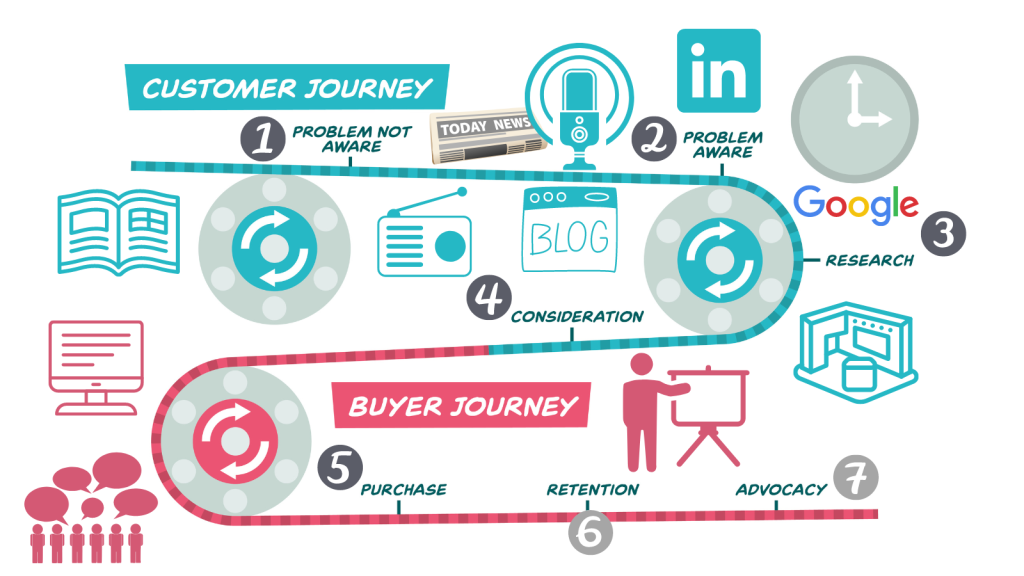
Taking our customer map from the previous stage, let’s look at this in a little more detail addressing each part of the customer journey:
1. Marketing along with Sales identify the key buyers the company is targeting in order to produce the right content for the right audience – they want to attract the ideal buyer!
2. Marketing plays a huge role here identifying influences of your buyers and producing content (Content Marketing) that address underlying problems that may rear their ugly head. No mention of who you are or your product/ service as you want to capture attention through their pain only
3. Marketing use for example articles, blogs and short form video to address underlying issues like why water authorities need to test for phosphates in our rivers thus educating the public which reduces any conflicts with water based companies changing the river dynamics – see Storms post here . The goal is awareness and education.
1. Marketing addresses questions and answers in blogs and socials posts to raise awareness and attract prospects towards their brand. Again no real mention of the product or service they are offering but answering questions potential clients have thus building a trust in the brand. You are not shoving your sales pitch down their throats.
2. Sales reach out to buyers on LinkedIn via liking, commenting and addressing questions through their postings, reactions to other posts etc. Sales then can link with potential customers but no mention of the product unless prompted.
3. Sales add contacts to their LinkedIn platform, knowing there audience will see their content addressing questions and keeping brand top of mind
4. Marketing builds awareness that the company will be exhibiting at a show and to find out how to solve X problem. Marketing produces educational materials like videos, short stories about potential problems their audience face.
1. Marketing produce more in depth content relating to solving those problems (thus nurturing a cold audience), inviting them to download white papers or attend exhibitions
2. Sales are hunting (prospecting) but not necessarily shouting about their products or services… subtle information is spread but answering questions they might get asked
3. Sales pass on questions and answers to marketing which in turn they will produce Q&As they can post as blogs and articles. Providing more in depth information which in turn will speed up the sales process because they are more knowledgeable and waste less time in the sales cycle
4. Marketing invite prospects to watch a webinar or download a white paper that is gated meaning the prospect has to include their contact information (thus list building for later nurturing by marketing)
5. Marketing sends out in depth information about webinar and further insights via list of contacts, via socials and on website
6. Prospect liaises with Sales person with questions. Sales feeds back to Marketing thus improving the content sent out and upping the overall level of brand awareness and educating the audience therefore always looking to speed up that process.
1. Marketing works with sales to produce FAQs, in depth white papers, webinar content and share this out – the aim with gated content is to build a list of the right kind of customer (hence why measuring your open rate is key to knowing if you are targeting the right buyer!)
2. Sales contact their LinkedIn friends and reach out to contacts inviting them to the webinar etc
3. More in depth Q&A via videos, case studies and testimonials is used to help the prospect make the best decision.
1. Marketing work with sales and support on content that address buying processors, how to guides to reduce the stress of purchasing and after sales care
1. By working in conjunction with each other you improve your brand
2. Marketing needs sales to get client feedback and input for a better understanding of the customer
3. Marketing needs sales to identify the right buyer personas so they can produce content for that persona thus attracting the right kind of buyer
5. Sales need marketing to build a strong brand, attract the right buyer and make the sales function smoother thus closing more sales
6. Marketing can warm up leads that are cold before handing them over to sales and sales converting more due to higher quality
7. Sales get highly qualified sales leads that they can then add further person-to-person value with supporting content to add value to the customer
8. Sales can give feedback on marketing efforts from feedback from customers and the market
9. Sales and marketing work in tandem to make the customer experience as smooth and easy as possible